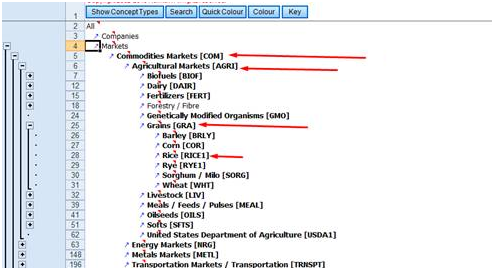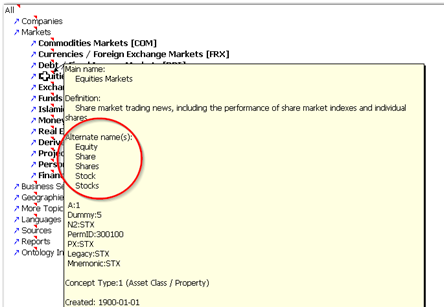RCS Topic Classification
RCS topic classification is a premium Intelligent Tagging capability. The Intelligent Tagging classification engine identifies the topics discussed in the input text and outputs DocCat (topic) tags. The reference list of topics includes over 1000 topics from the RCS (Refinitiv Classification Services) taxonomy.
The list of supported RCS topics is available to premium users on MyRefinitiv. This file is updated every few weeks to include newly released topic classifiers, so we recommend downloading it regularly.
See How Does Intelligent Tagging Work? for a detailed conceptual overview of the DocCat tag and some output examples.
Legacy Classifiers vs. Classifiers Optimized for News or Research Input
The Intelligent Tagging classification engine is comprised of over 1500 RCS topic classifiers. Most of the topics are supported by underlying classification models that are optimized for tagging news stories, research reports, transcripts, and/or filings. A small number of topics (around 100) are supported by legacy classification models only. The optimized classifiers are of higher quality than the legacy classifiers; however, the legacy classifiers extend the coverage.
Both the legacy and the optimized classifiers are active during production. Your output may include topic tags generated by the legacy classifiers and topic tags generated by optimized classifiers.
If the same topic is identified by both a legacy classifier and an optimized classifier, then only the tag assigned by the optimized classifier is included in the tagging response. We are gradually training optimized models for the topics currently supported by legacy classifiers only.
Input Headers that Affect Classification
- x-calais-contentClass - This header value (News, Research, or Transcripts) determines which classifiers are enabled.
News: all the legacy topic classifiers plus the topic classifiers optimized for news stories are enabled.
Research: all the legacy topic classifiers plus the topic classifiers optimized for research reports are enabled.
Transcripts: all the legacy topic classifiers plus the topic classifiers optimized for transcripts are enabled.
Please note that currently, if the contentClass is not defined, input is processed as if the contentClass is News.
- x-calais-selectiveTags - This header is mandatory for new users and soon-to-be mandatory for all users. x-calais-selectiveTags determines which of the Intelligent Tagging processes are triggered. Pass one of the following values to trigger topic tagging: topic-all; topic; topic-sca; topic-selfservice.
topic-all: Triggers IPTC and RCS topic tagging.
topic: Triggers RCS topic tagging only. This value triggers both the legacy RCS topic classifiers and the optimized RCS topic classifiers. If the same RCS topic is identified by both a legacy topic classifier and an optimized classifier, then only the topic tag assigned by the optimized topic classifier is included in the response.
topic-selfservice: Triggers the optimized RCS topic classifiers. The tagging output may include fewer topics, but with higher confidence of accuracy.
topic-sca: Triggers the legacy RCS topic classifiers.
ForEndUserDisplay
The forenduserdisplay attribute is a recommendation of whether the tag is suitable as a search item for a specific document (true) or whether the metadata is primarily of use for aggregation and analytics on large quantities of documents (false). Generally speaking, the “true” status is assigned to topics that consistently provide high precision and recall results.
Topic tags output by the optimized classifiers are assigned the forenduserdisplay=True value.
Hierarchical Tree View of RCS Topics
The file RCS Eikon News TRBC 2012 View Plus Tree, available to premium users on MyRefinitiv, provides a hierarchical tree view of all the RCS topics. The file also includes synonyms for topic names, and topic identifiers such as RCS codes, N2000 codes, PermIDs, and Eikon News mnemonics.
The Intelligent Tagging classification engine supports over 1000 of the RCS topics.
From the Hierarchical Tree View file, you can extract data related to the RCS topics supported by Intelligent Tagging, to expand your search capabilities, provide context, build a knowledge graph, and more.
To leverage the data contained in the hierarchical tree view...
Write code to programmatically map the list of RCS topics supported by Intelligent Tagging to all the parents in the Hierarchical Tree View, and to extract any other information relevant to your use case from the Hierarchical Tree View file.
In the CSV file that lists the RCS topics supported by Intelligent Tagging, the topics are identified by RCS code; in the Hierarchical Tree View, the RCS topics are identified by N2000 code. The comment boxes in the Hierarchical Tree View file contain all the identifiers.
An example of how to programmatically retrieve cell comments.
Both the Excel file that lists the RCS topics supported by Intelligent Tagging and the Hierarchical Tree View Excel file are available to premium users on MyRefinitiv.
Use Parents to Expand Search
You can use the parents of the topics supported by Intelligent Tagging to enhance searchability.
For example, Intelligent Tagging supports the topic, “Rice.”
If you add Grains, Agricultural Markets, and Commodities Markets to your search engine and associate “Rice” with these topics, then documents classified as being about Rice will be included in search results for any of these terms.

Use Synonyms to Enhance Search
The Excel file also provides synonyms (alternate names) for some of the topics. You can incorporate the synonyms into your search engine to enrich the list of terms associated with a topic for search purposes.
The synonyms are found in the comment boxes. To open a comment box, hover over the red arrow.

Provide Context
You can use the hierarchy to provide context. For example, if a person searches for rice, you might want to offer the relevant suggestions of other types of grain: corn, rye, sorghum, and wheat.
Build a Knowledge Graph
You can use the tree view to identify relationships. For example, between Wheat and Rice, which share a common parent. This can be useful when building a graph.